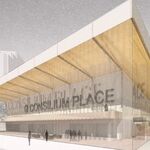When 80% of CityPlace residents walk around WITHOUT a car, it's just ignorant to compare it the suburbs. It's just as much a lively neighbourhood as any other downtown neighbourhood. Less families and kids, but so what? It's a seven minute walk to King and Bay for heaven's sakes.
I'm not saying the location isn't urban. That's exactly my point, this is very much a downtown, urban neighbourhood, which is why I wanted it to look, feel and function, as a part of downtown. I'm not talking about height or density, when I say it feels suburban. I'm talking about how it meets the street. (the way it feels) It feels very isolated in parts, for a downtown area.
Cityplace was designed so that Fort York Blvd would function as its main street/thoroughfare. That's why it was designed wide enough for streetcars. It's just natural that Fort York Blvd would have been used as the main commercial and social heart of the community. That whole area would have been so much more animated, lively, interesting and safe, if it was. I just think there were bad zoning and design choices made here. I blame both the city and Concord. They both missed a great opportunity to bring people, jobs and fun, to an area that needs it.
The park (Canoe Landing) just doesn't cut it as a social centre. People are too segregated into distant sections, with dog walkers here and soccer players there. There is very little interaction. It feels very un-urban and not lively at all, even on warm, summer days. I was just there today (sunday afternoon) and it felt very segregated. There is not even a central meeting place in the park. New York could teach us a lesson, in that regard. Parks there always have a central, social core for interacting with fellow New Yorkers. Our parks usually lack that design feature.
I see certain similarities between Cityplace and St. Jamestown. St. Jamestown is also a high-density, downtown neighbourhood with tall buildings and a few retail spaces here and there. It also has many residents who walk to work or use public transit. In that regard, it's quite urban. The problem is St. Jamestown has no central core where retail and social activities come together. It's isolated and cut off from much of the city. It is different from CP, in that way and it's more of a "towers in the park" development. If St. Jamestown had a main street lined with retail, services and cafes, where people could socialize, it would have been a much more successful development. Of course, the social housing and poverty play a big role but they were not a part of this development when it was first built. I think that came much later. Take away those towers in the park bullshit and throw in some interesting retail/services on the ground level and this neighbourhood might have had a chance.
It's not rocket science. If you look at the cities people most visit, they ALL have streets lined with retail, coffee shops, nightclubs, theatres and more. Europe seems to know how to do this best. I guess it's no surprise that London and Paris are the role models for me. I lived there for almost 6 months and I just felt so comfortable with this type of urban environment. Of course, the scale of London and Paris is quite different than Cityplace or SJT but the same principles apply. Hell, it even applies to small town Ontario's main streets. Tightly packed retail almost always works. Tiny bits of retail, here and there, just doesn't cut it.
And as for Spadina, the part south of Front Street, is basically a highway ramp. It is NOT a good place for retail, outdoor cafes or restaurants. There is much too much traffic for it to ever become a good retail strip or a meeting place. People walk quickly, to get off that car-chocked street, so a Shwarma restaurant may provide a useful service but it will do nothing to animate the street. The banks only KILL the animation, they are the worst.
For me, it's ALL about the animation and creating safe, lively, walkable, interesting districts, that give as much back to the city, as they take. One of the saddest things I find about Toronto, is all the lost opportunities for good design. We have the potential, towers going up everywhere, yet so many times, we end up with another lost opportunity. Once it's lost, it's frequently, lost forever. (or a really long time) I don't want to keep seeing lost opportunities in this city. I want to see development that makes me smile, when I walk by it.
One last note, YES, I know Cityplace is NOT finished and I do have hope a retail strip or something else interesting, will develop along Fort York Blvd. I just wish it was designed into the buildings originally, as it would have been so much better than converting what's there now. I don't hate Cityplace, I just think we need to do better.
(MUCH BETTER!)




